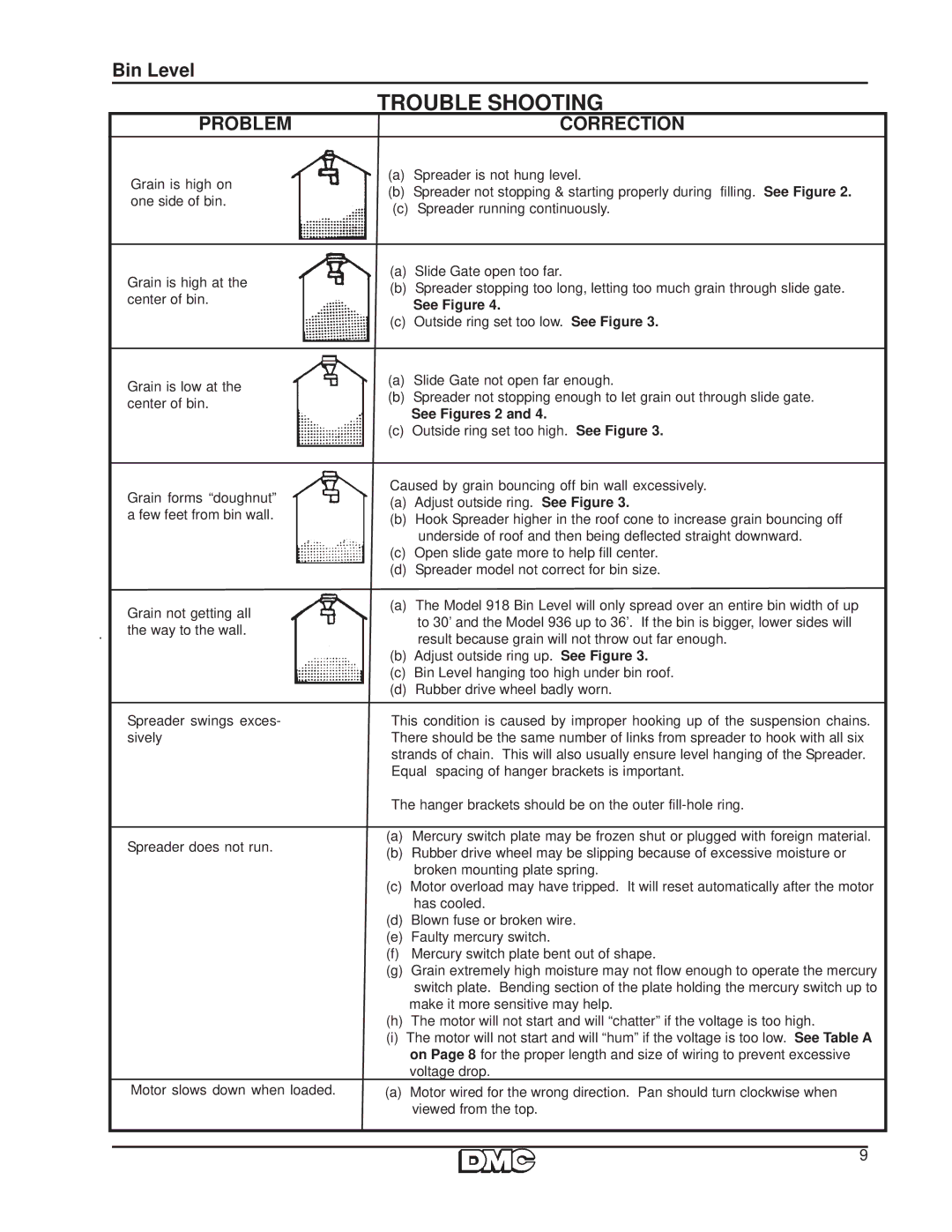
Bin Level
TROUBLE SHOOTING
PROBLEM |
| CORRECTION | |
Grain is high on | (a) | Spreader is not hung level. | |
(b) | Spreader not stopping & starting properly during filling. See Figure 2. | ||
one side of bin. | |||
(c) | Spreader running continuously. | ||
| |||
|
|
| |
Grain is high at the | (a) | Slide Gate open too far. | |
(b) | Spreader stopping too long, letting too much grain through slide gate. | ||
center of bin. | |||
| See Figure 4. | ||
|
| ||
| (c) | Outside ring set too low. See Figure 3. | |
|
|
| |
Grain is low at the | (a) | Slide Gate not open far enough. | |
(b) | Spreader not stopping enough to let grain out through slide gate. | ||
center of bin. | |||
| See Figures 2 and 4. | ||
|
| ||
| (c) | Outside ring set too high. See Figure 3. |
Grain forms “doughnut” a few feet from bin wall.
Caused by grain bouncing off bin wall excessively.
(a)Adjust outside ring. See Figure 3.
(b)Hook Spreader higher in the roof cone to increase grain bouncing off underside of roof and then being deflected straight downward.
(c)Open slide gate more to help fill center.
(d)Spreader model not correct for bin size.
Grain not getting all the way to the wall.
(a)The Model 918 Bin Level will only spread over an entire bin width of up to 30’ and the Model 936 up to 36’. If the bin is bigger, lower sides will result because grain will not throw out far enough.
(b)Adjust outside ring up. See Figure 3.
(c)Bin Level hanging too high under bin roof.
(d)Rubber drive wheel badly worn.
Spreader swings exces- | This condition is caused by improper hooking up of the suspension chains. |
sively | There should be the same number of links from spreader to hook with all six |
| strands of chain. This will also usually ensure level hanging of the Spreader. |
| Equal spacing of hanger brackets is important. |
| The hanger brackets should be on the outer |
(a) Mercury switch plate may be frozen shut or plugged with foreign material.
Spreader does not run.(b) Rubber drive wheel may be slipping because of excessive moisture or broken mounting plate spring.
(c)Motor overload may have tripped. It will reset automatically after the motor has cooled.
(d)Blown fuse or broken wire.
(e)Faulty mercury switch.
(f)Mercury switch plate bent out of shape.
(g)Grain extremely high moisture may not flow enough to operate the mercury switch plate. Bending section of the plate holding the mercury switch up to
make it more sensitive may help.
(h)The motor will not start and will “chatter” if the voltage is too high.
(i)The motor will not start and will “hum” if the voltage is too low. See Table A on Page 8 for the proper length and size of wiring to prevent excessive voltage drop.
Motor slows down when loaded.
(a)Motor wired for the wrong direction. Pan should turn clockwise when viewed from the top.
9
